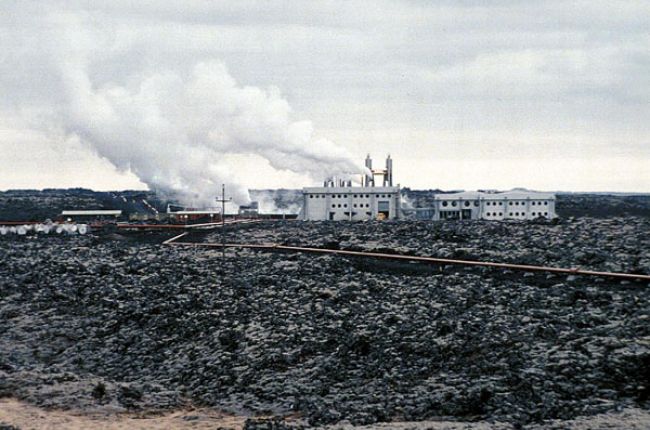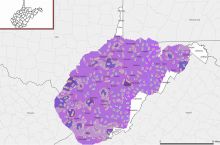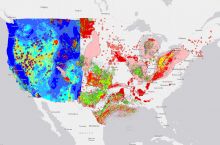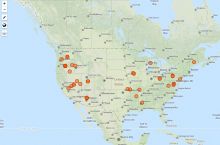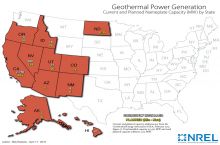Geothermal energy comes from the heat of the Earth’s interior. Reservoirs of steam or hot water with temperatures higher than about 225°F can generate electricity,[1] while lower-temperature geothermal fluids are often used directly for heating and other applications.[2] In western states like California and Nevada, hot rocks beneath the Earth’s surface create shallow hot water reservoirs. Scientists are developing enhanced geothermal systems to extract heat from hot, dry rocks in order to produce electricity.
Why does geothermal matter?
In 2017, only 0.4% of U.S. electricity came from geothermal energy sources,[3] but the U.S. Geological Survey estimates that geothermal energy could generate more than 10% of the nation’s electricity.[4] While geothermal has historically been limited to western states with shallow hot water reservoirs, enhanced geothermal systems may make it possible to extract geothermal energy from hot, dry rocks throughout the country.
How does geoscience help?
Geoscientists identify geothermal resources and estimate how much energy they can provide, including developing ways to create enhanced geothermal systems. They also investigate the environmental impacts of geothermal energy development and study how to manage existing geothermal systems.
References
1 Geothermal - Electricity Generation, DOE, https://www.energy.gov/eere/geothermal/electricity-generation
2 Geothermal Heat Pumps, DOE, https://www.energy.gov/eere/geothermal/geothermal-heat-pumps
3 Use of Geothermal Energy, EIA, https://www.eia.gov/energyexplained/index.php?page=geothermal_use
4 Assessment of moderate- and high-temperature geothermal resources of the United States, U.S. Geological Survey, https://pubs.usgs.gov/fs/2008/3082/
Learn More
Introductory Resources
- Geothermal Explained (Webpage), Energy Information Administration
An overview of the source of geothermal energy, types of geothermal power plants, locations of geothermal energy, geothermal heat pumps, and brief discussion of geothermal energy and the environment.
- What You Need to Know About Energy: Renewable Sources (Webpage), The National Academies
An in-depth overview of the current role of each renewable energy source in the United States, the benefits and disadvantages of each energy source, and opportunities and challenges for using that energy source in the future. (Discusses geothermal, wind, solar, hydroelectric, biomass.)
- Learning About Renewable Energy (Webpage), National Renewable Energy Laboratory
Basic overview of renewable energy sources and technologies, including biomass, geothermal, hydrogen & fuel cells, hydropower, ocean, solar, and wind energy. Provides links to more information on each topic.
Resources for Educators
- Education Resources Network, AGI's Center for Geoscience & Society
Search for geothermal energy resources in: Curricula & Instruction
- NGSS Performance Expectations, Next Generation Science Standards
K-ESS3-1, 4-ESS3-1, MS-ESS3-1, HS-ESS3-1, HS-ESS3-2
- NGSS Disciplinary Core Ideas, Next Generation Science Standards
ESS3.A

